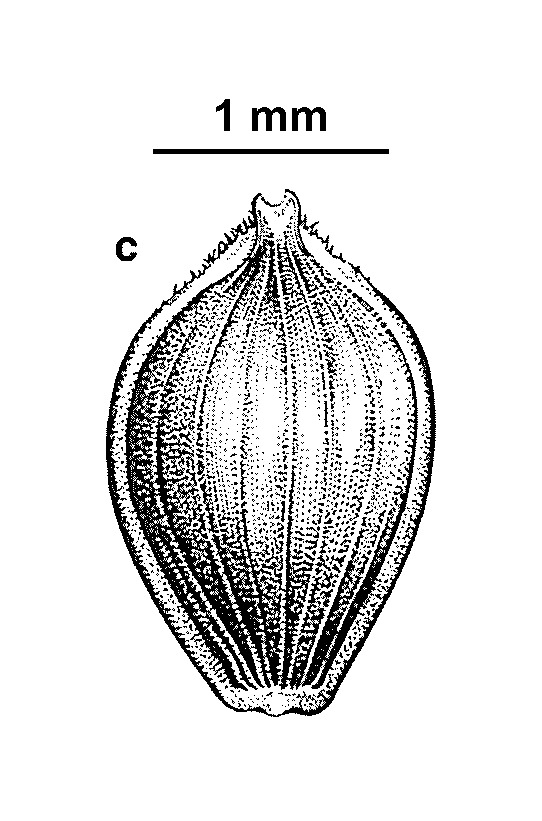Carex incomitata
K.Thiele Hillside SedgeRhizome short; shoots loosely tufted. Culms erect to spreading, ± trigonous, scabrous at least near apex, 25–90 cm long, 2.5–3.5 mm diam., solid. Leaves often septate-nodulose, shorter than or equalling culms, 4–8 mm wide, usually rather flaccid, margins retrorsely scabrous; sheath pale grey-brown, leaf sheath front (inner face) not cross-rugulose; ligule obtuse. Inflorescence narrow, erect, 3–12 cm long, compound, with numerous short spikes solitary at nodes or on appressed, spike-like secondary branches to c. 1 cm long; lowest involucral bract very short. Spikes sessile, contiguous, appressed to erect at maturity, c 0.5 cm long; all spikes with male flowers above female flowers; glumes obtuse to truncate, erose, shortly mucronate, whitish with green midrib; female glumes 1.5–2.5 mm long; utricles 1.8–3 mm long, c. 1.5 mm diam., ellipsoid, slightly winged or ribbed on upper margins, not corky, tapered at base, strongly several-nerved, slightly hispid on shoulders and beak, green to blackish; beak c. 0.3 mm long, with apex notched; style 2-fid. Nut obovoid to ellipsoid, lenticular, pale yellow-brown. Flowers spring–summer.
GleP, VVP, VRiv, GipP, Gold, CVU, NIS, EGL, EGU, HSF, HNF, Strz, MonT, HFE, VAlp. Also NSW. Occasional in dryish to damp, often somewhat elevated sites in the east, often on fertile soils (e.g. alluvial flats and terraces). Rather rare west of Melbourne (e.g. St Albans, Moorabool River, Lower Glenelg River).
Occurs in drier habitats than the similar Carex appressa from which it differs in the loosely tufted habit, the usually shorter inflorescence, the utricle not thickened at the base, and the leaves with denser, retrorsely scabrous margins (except near the apex, where the scabrosities may be erect or antrorse; the prickles are regularly antrorse in C. appressa). The leaves are often septate-nodulose when dried, as in C. appressa, and C. declinata (occurs in New South Wales, and Queensland). C. declinata differs in having the utricle margins glabrous, and unwinged.
Wilson, K.L. (1994). Cyperaceae. In: Walsh, N.G.; Entwisle, T.J., Flora of Victoria Vol. 2, Ferns and Allied Plants, Conifers and Monocotyledons, pp. 238–356. Inkata Press, Melbourne.
 Spinning
Spinning
